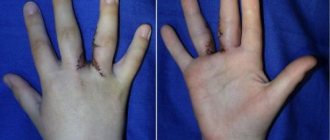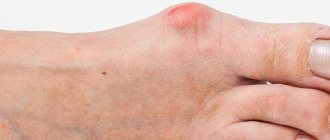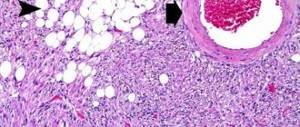Causes of numbness in fingers
Certain diseases can cause functional disorders of the innervation of the lower extremities. The main ones include the following:
- Osteochondrosis is a pathological process in the intervertebral discs, which is characterized by their thinning, resulting in pinching of the spinal root. The consequence of pinching is an obstacle to the passage of nerve impulses, which contributes to the numbness of the big toes.
- Atherosclerosis – due to the deposition of cholesterol plaques on the inner surface of blood vessels, their lumen narrows significantly, and proper blood flow is disrupted. Atherosclerosis, localized in the femoral artery, causes numbness in the fingers, which then spreads to the lower leg and thigh area.
- Rheumatoid arthritis is characterized by inflammation of the knee joints, as a result of which the nerve responsible for the innervation of the lower limb is pinched in the kneecap. First, the big toe on the right foot becomes numb, and then the numbness spreads to the entire foot and lower leg.
- Protrusions are a complicated degree of osteochondrosis. They can often cause complete loss of sensation in the legs.
- Gout is characterized by the deposition of uric acid salts on the joints. In this case, the big toe especially suffers; at first it becomes numb, and over time severe pain appears.
- Big toes also go numb during pregnancy, this is due to a lack of vitamin B. It ensures the proper functioning of peripheral nerves. With a lack of vitamin, the functioning of the nerves is disrupted and numbness of the fingers and toes occurs.
This list is only a small part of the reasons that cause numbness in the fingers and lower extremities.
What does a person feel?
Numbness (paresthesia) is experienced subjectively. For example, as one of the manifestations listed below, any combination or complete complex.
- Loss of sensation.
- Burning.
- Inability to move fingers or bend them.
- Tingling with thousands of “needles”.
- Goosebumps.
- Itching.
- Discomfort.
Whatever the sensation, if a person’s toes are numb, treatment should be preceded by an adequate examination that will help identify the underlying causes of the disease.
Symptoms of numbness in limbs
You can find out the cause of numbness by determining the location of the unpleasant tingling sensation and decreased sensitivity.
- If there is reduced sensitivity in only one leg and pain in the lower back, it is necessary to pay special attention to the condition of the spine and intervertebral discs. With protrusion and osteochondrosis, as a rule, the big toe on the right foot goes numb.
- A pinched sciatic nerve is characterized by numbness of the limb on the inside, starting from the big toe and reaching to the knee.
- A general loss of sensation in the limbs indicates polyneuropathy. It can be caused by intoxication of the body, in which disease of the peripheral nerves occurs with disruption of the conduction of nerve impulses.
- Big toes go numb most often due to diabetes and atherosclerosis. In this case, the loss of sensation is localized from the toes throughout the foot.
When visiting a doctor, you must clearly explain to him all the unpleasant symptoms.
Which doctor should I contact?
More often than not, numbness in the fingers is a minor problem that can be easily corrected on your own. If this happens repeatedly, you need to consult a general practitioner to rule out the underlying disease.
Consult your doctor:
- If you suddenly feel tingling or numbness for no apparent reason.
- If symptoms are severe and persist.
- During pregnancy, if your fingers and feet become numb and swollen.
- If finger sensitivity is associated with symptoms such as paralysis, loss of bowel or bladder control, or weak articulation, seek immediate medical attention.
- It is necessary to consult a doctor during sensation disorders that appear regularly. If the pain results in sensory visual disturbances, paralysis, dizziness, nausea or skin reactions.
To solve the problem, you need to find out the cause of the symptom. Most likely, the loss of sensation is associated with nerve pathways, circulatory or lymphatic circulation. You need to see a therapist. He will determine the main cause of the disease and refer you for diagnosis or to a specialist.
There are different reasons:
- Nerve disorders are mechanical damage to a nerve due to muscle tension along the spine, in the sacroiliac joint or pelvis.
- Excessive pressure on the toes after wearing shoes that are too narrow, heels that are too high, or shoes that don't fit.
- Side effects on the nerves due to chemotherapy (polyneuropathy). Polyneuropathy caused by other diseases of the nervous system: Parkinson's disease, fibromyalgia.
- Problems affecting blood vessels, veins, arteries, lymphatic system.
- All mechanical obstacles that interfere with blood or lymph circulation, excess weight. Diseases that have the indirect effect of insufficient blood or lymph circulation.
- If you have diabetes or another medical condition, you need to take your symptoms and health conditions seriously.
- The sensation of numbness indicates a temporary lack of nerve activity, pathological changes, or decreased sensitivity to stimuli. Sometimes the nerves become damaged in the affected areas and lose their function. Numbness in the fingers is often associated with poor circulation or lymphatic drainage.
↑
Diagnostic measures
To prescribe appropriate treatment, it is necessary to conduct a comprehensive examination, thanks to which the full picture of what is causing numbness in the legs will be visible. Basic examination methods:
- radiography;
- Ultrasound;
- tomography;
- blood test to determine the amount of minerals and vitamins.
A comprehensive examination allows you to correctly identify the cause that causes decreased sensitivity in the legs and frequent tingling, and prescribe the necessary medications that will not only neutralize the symptoms, but also have an impact on the cause itself.
Diagnostics
Numbness in the toes can be caused by a variety of causes, and treatment will vary accordingly. To find out what pathology gives rise to this symptom, it is necessary to undergo a clinical examination:
- An anamnesis is collected in order to establish what other complaints arose in the near future, what diseases were suffered;
- general blood test, sugar test - to detect diabetes, diseases of the hematopoietic organs, inflammatory processes;
- A urine test will help identify kidney disease;
- radiography - if a fracture or crack is suspected, as well as to identify cancerous tumors and degenerative diseases of the joints.
If necessary, you also need to go through:
- Electromyography;
- Ultrasound of the kidneys;
- Angiography;
- CT and MRI.
There are many methods of treatment, both in official and traditional medicine, but it is unacceptable to self-medicate.
If a disease has been detected, it is necessary to follow all the instructions of the attending physician. Share:
Numb fingers: treating symptoms and causes with an integrated approach
Complex therapy is prescribed only after identifying the true cause of numbness in the limbs. It includes the following necessary activities:
- Taking medications or surgery to relieve pressure on the nerve roots.
- Vitamin complexes containing vitamin B. They help normalize metabolic processes in nerve fibers.
- Prescription of drugs that reduce the number of cholesterol plaques. This class of drugs belongs to statins and directly lowers cholesterol levels in the blood.
- Taking medications that affect the quality of blood circulation, improving it and activating the passage of nerve impulses.
- Medicines that reduce the amount of uric acid deposits on joints.
Physiotherapeutic treatment, which includes restorative mud baths and paraffin baths, will be very useful.
Prevention of innervation disorders of the legs
To avoid tingling and decreased sensitivity of the lower extremities, it is necessary to monitor activity during the day and not load your back with unbearable weight. All these actions contribute to the numbness of the big toes. The causes must be eliminated as early as possible to prevent irreversible changes in the body.
That is why it is regularly necessary to ensure an active lifestyle and massage, which prevents pinching of the spinal nerve roots or central nerve lines that transmit impulses to the peripheral nerves.
It’s not difficult to determine why your fingers go numb. It is only important to carry out a complete diagnosis and get an appointment with an experienced, highly qualified doctor.
Treatment options
Before prescribing treatment, a comprehensive diagnosis should be carried out, including:
- X-ray of the lumbar spine;
- CT (computed tomography);
- MRI (magnetic resonance imaging);
- General blood and urine analysis.
The treatment regimen for big toe numbness includes:
- Prescription of medications: NSAIDs (Nonsteroidal anti-inflammatory drugs) – Ibuprofen, Nurofen, Diclofenac; painkillers - Penialgin, Analgin; medications to activate blood flow and restore innervation of the legs;
- Massaging numb areas helps to quickly get rid of discomfort caused by wearing tight shoes, staying in a static position for a long time, or hypothermia. Massage normalizes blood flow and restores sensitivity of the limb;
- Performing exercise therapy exercises;
- Physiotherapeutic procedures: paraffin baths, laser and magnet treatment, electrophoresis, baths with mineral water and healing mud;
- Contrast shower for feet.
Folk remedies for numbness should only be used after consultation with a doctor. Rubbing with alcohol tincture effectively eliminates discomfort. To prepare it, grate 2 cucumbers and a pod of hot chili pepper, pour the pulp with a glass of vodka or moonshine. Infuse for 7 days in a cool place.
Another recipe: grate two lemons on a coarse grater, chop a kilogram of celery root and a kilogram of parsley root. Add a glass of liquid honey. Take 1 tablespoon before meals.
Ways to treat numbness of the big toe
After a comprehensive examination, the doctor will begin treatment.
Therapy is carried out in the following sequence:
- Localization of symptoms. For this purpose, drugs are prescribed that normalize blood circulation, muscle relaxants, painkillers and others, depending on the cause of the disease.
- If the problem is vertebrogenic processes, then vascular drugs and B vitamins are prescribed.
- Physiotherapeutic procedures.
- Massage.
- Physiotherapy.
- Acupuncture.
- Carrying out manual therapy. The sessions improve blood flow, and the connection between the peripheral nerves and the central system is restored.
We suggest that you familiarize yourself with Treatment of nail onychomycosis with inexpensive effective drugs
If the cause of numbness is hidden in tired legs or incorrectly selected shoes, then to relieve the symptom the doctor will suggest:
- foot massage;
- warm compress;
- changing shoes to more comfortable ones.
Treatment depends on the underlying cause.
| Disease | Therapy | Drugs |
| Diabetes | Antidiabetic drugs to prevent complications | Metformin Gliquidone |
| Peripheral vascular diseases | Vasodilators | Trental Persactin |
| Gout | NSAID drugs | Colchicine, prednisolone |
| Radiculopathy | Muscle relaxants to relieve spasms | Baclofen, Flexeril, Soma, Tylenol |
| NSAIDs | Motrin, Naproxen, Tylenol | |
| Vitamin deficiency | B vitamins | Binavit Pentavit |
Vitamin B12 can be obtained additionally by including milk, seafood, red meat, and fish in your diet.
Traditional methods
If the examination does not reveal serious causes of the disease, then you can try home treatment:
- Foot massage will improve blood circulation. For massage, take a little olive or sunflower oil and rub it in your palm. Massage with circular movements for at least 5 minutes.
- Massage with turmeric solution. Prepare a paste from water and 1 tsp. powder. Massage your finger in a circular motion, rubbing in the paste.
- Warming your feet with a heating pad or warm water will help relieve numbness. Soak a linen rag or washcloth in hot water, wring it out, cool slightly and apply to the affected area of the skin. Keep the fabric for 5-7 minutes. Repeat several times until the symptom disappears.
- Massage with primrose oil. Take 1–2 tsp. oil, apply to the thumb and massage gently for 15–20 minutes. Then rinse with warm water. Perform the procedure 2-3 times a day. The oil is an excellent source of amino acids, magnesium, iron and phosphorus. Has a calming effect on the nervous system.
- Massage with lavender oil. This is done in the same way as with primrose oil. Has an anti-inflammatory effect.
- Massage with mustard oil. Heat ½ cup oil in the microwave. Cool slightly, if too hot, rub it in your hand and massage it around your thumb. Leave the oil for 40 minutes, then rinse with warm water. Repeat the procedure 2-3 times a day.
- Soaking your finger in a bath with added Epsom salt. Mix ½ cup of salt with warm water, then place your foot in the solution for 10 minutes. The procedure can be repeated until the unpleasant symptom disappears.
- Honey wrap helps restore the activity of the finger. It can be done at night as a compress.
Drinks to help relieve numbness:
- Add 1 tsp. turmeric powder in a glass of milk. Heat the mixture, add a little honey. Drink once a day to improve blood flow.
- Dilute 1 tsp in a glass of milk. cinnamon without sugar. Drink the solution once a day.
- A drink based on cayenne pepper, ginger, garlic. Grind ½ tsp. garlic, ½ tsp. ginger, add 1 tsp. cayenne pepper. Mix everything. Heat 1-2 cups of water over a fire, add the dry mixture to it. Leave for 5–6 minutes. Strain and pour into a clean container. Drink the decoction 2-3 times a week until complete relief.
To relieve the unpleasant symptom, you should add foods containing magnesium to your diet: dark green vegetables, seeds, oatmeal, nuts, bananas. You can take 350 mg of magnesium supplements per day.
Physical exercises that should be performed every morning will help improve blood circulation and prevent numbness. Among the exercises of therapeutic gymnastics, tiptoe walking and finger exercises are especially useful.
Other methods
An additional technique aimed at restoring impaired blood circulation and relieving spasms includes physiotherapy:
- Electrophoresis using drugs.
- Magnetotherapy. Treatment with pulsed fields improves microcirculation and relieves inflammation.
Electrophoresis helps the drug penetrate deep into the legs, which is why it is often used in the treatment of numbness in the fingers - Ion therapy. A method of introducing medicinal substances into the body through the skin through ionogalvanization. The more superficial the painful area is, the better the effect of galvanic current on it.
At the next stage, the doctor will recommend massage and exercise therapy. These procedures are useful for pinched nerves and muscle spasms.
If numbness of the thumb is caused by a bulging disc, hernia, or spinal stenosis, then spinal surgery is performed depending on the location of the disease:
- laminectomy, minimally invasive surgery;
- microsurgical discectomy;
- foraminotomy, a minimally invasive procedure.
Alternative treatment methods include acupuncture and manual therapy. These procedures are indicated if numbness of the finger occurs due to osteochondrosis, sciatica, or disorders of the spine.
We invite you to familiarize yourself with Callus on the big toe: causes, types, treatment methods
The toe (big) is numb, and if this is due to muscle atrophy and paralysis, the doctor will recommend physical therapy sessions.











